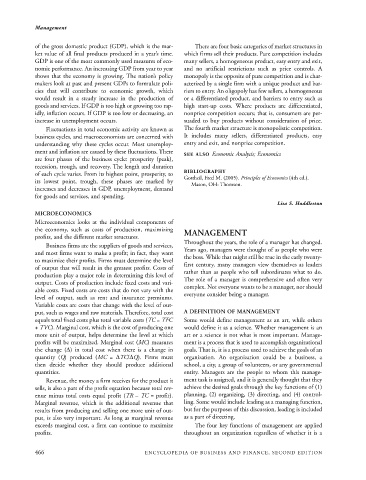Page 489 - Encyclopedia of Business and Finance
P. 489
eobf_M 7/5/06 3:15 PM Page 466
Management
of the gross domestic product (GDP), which is the mar- There are four basic categories of market structures in
ket value of all final products produced in a year’s time. which firms sell their products. Pure competition includes
GDP is one of the most commonly used measures of eco- many sellers, a homogeneous product, easy entry and exit,
nomic performance. An increasing GDP from year to year and no artificial restrictions such as price controls. A
shows that the economy is growing. The nation’s policy monopoly is the opposite of pure competition and is char-
makers look at past and present GDPs to formulate poli- acterized by a single firm with a unique product and bar-
cies that will contribute to economic growth, which riers to entry. An oligopoly has few sellers, a homogeneous
would result in a steady increase in the production of or a differentiated product, and barriers to entry such as
goods and services. If GDP is too high or growing too rap- high start-up costs. Where products are differentiated,
idly, inflation occurs. If GDP is too low or decreasing, an nonprice competition occurs; that is, consumers are per-
increase in unemployment occurs. suaded to buy products without consideration of price.
Fluctuations in total economic activity are known as The fourth market structure is monopolistic competition.
business cycles, and macroeconomists are concerned with It includes many sellers, differentiated products, easy
understanding why these cycles occur. Most unemploy- entry and exit, and nonprice competition.
ment and inflation are caused by these fluctuations. There
SEE ALSO Economic Analysis; Economics
are four phases of the business cycle: prosperity (peak),
recession, trough, and recovery. The length and duration
BIBLIOGRAPHY
of each cycle varies. From its highest point, prosperity, to
Gottheil, Fred M. (2005). Principles of Economics (4th ed.).
its lowest point, trough, these phases are marked by
Mason, OH: Thomson.
increases and decreases in GDP, unemployment, demand
for goods and services, and spending.
Lisa S. Huddlestun
MICROECONOMICS
Microeconomics looks at the individual components of
the economy, such as costs of production, maximizing MANAGEMENT
profits, and the different market structures.
Throughout the years, the role of a manager has changed.
Business firms are the suppliers of goods and services,
Years ago, managers were thought of as people who were
and most firms want to make a profit; in fact, they want
to maximize their profits. Firms must determine the level the boss. While that might still be true in the early twenty-
of output that will result in the greatest profits. Costs of first century, many managers view themselves as leaders
rather than as people who tell subordinates what to do.
production play a major role in determining this level of
The role of a manager is comprehensive and often very
output. Costs of production include fixed costs and vari-
complex. Not everyone wants to be a manager, nor should
able costs. Fixed costs are costs that do not vary with the everyone consider being a manager.
level of output, such as rent and insurance premiums.
Variable costs are costs that change with the level of out-
put, such as wages and raw materials. Therefore, total cost A DEFINITION OF MANAGEMENT
equals total fixed costs plus total variable costs (TC = TFC Some would define management as an art, while others
+ TVC). Marginal cost, which is the cost of producing one would define it as a science. Whether management is an
more unit of output, helps determine the level at which art or a science is not what is most important. Manage-
profits will be maximized. Marginal cost (MC) measures ment is a process that is used to accomplish organizational
the change (D) in total cost when there is a change in goals. That is, it is a process used to achieve the goals of an
quantity (Q) produced (MC = DTC/DQ). Firms must organization. An organization could be a business, a
then decide whether they should produce additional school, a city, a group of volunteers, or any governmental
quantities. entity. Managers are the people to whom this manage-
Revenue, the money a firm receives for the product it ment task is assigned, and it is generally thought that they
sells, is also a part of the profit equation because total rev- achieve the desired goals through the key functions of (1)
enue minus total costs equal profit (TR – TC = profit). planning, (2) organizing, (3) directing, and (4) control-
Marginal revenue, which is the additional revenue that ling. Some would include leading as a managing function,
results from producing and selling one more unit of out- but for the purposes of this discussion, leading is included
put, is also very important. As long as marginal revenue as a part of directing.
exceeds marginal cost, a firm can continue to maximize The four key functions of management are applied
profits. throughout an organization regardless of whether it is a
466 ENCYCLOPEDIA OF BUSINESS AND FINANCE, SECOND EDITION

